Pepin County, Wisconsin
Pepin County | |
|---|---|
U.S. county | |
 Historic Pepin County Courthouse Museum in Durand, Wisconsin | |
 Location within the U.S. state of Wisconsin | |
 Wisconsin's location within the U.S. | |
| Coordinates: 44°36′N 92°00′W / 44.6°N 92°W | |
| Country | |
| State | |
| Founded | February 25, 1858 |
| Named for | Lake Pepin |
| Seat | Durand |
| Largest city | Durand |
| Area | |
| • Total | 249 sq mi (640 km2) |
| • Land | 232 sq mi (600 km2) |
| • Water | 17 sq mi (40 km2) 6.7%% |
| Population (2010) | |
| • Total | 7,469 |
| • Estimate (2020) | 7,271 |
| • Density | 30/sq mi (12/km2) |
| Time zone | UTC−6 (Central) |
| • Summer (DST) | UTC−5 (CDT) |
| Congressional district | 3rd |
| Website | www |
Pepin County is a county in the U.S. state of Wisconsin. As of the 2010 census, the population was 7,469,[1] making it the fourth-least populous county in Wisconsin. Its county seat is Durand.[2]
Pepin County is the birthplace of Laura Ingalls Wilder, the author of the Little House on the Prairie children's books.
History[]
Pepin County was formed in the year 1858 from portions of neighboring Dunn County. Both the town of Pepin (originally named North Pepin in 1856), and the village of Pepin were named after Lake Pepin, a broadening of the Mississippi River between Pepin County and the Counties of Goodhue and Wabasha in the state of Minnesota. The lake itself is likely named for one or more of the Pepin families from the French Canadian city of Trois-Rivières in Quebec, Canada. Several Pepins appear in the early records, including the senior figure Guillaume dit Tranchemontagne and his descendants Pierre and Jean Pepin du Chardonnets. One or both of the latter may have accompanied Daniel Greysolon, the Sieur du Lhut, from Montreal to what is now Duluth, Minnesota, in 1679. Exactly when the body of water was first named Pepin is not known, but the name has been used as early as 1700, making it by far one of the oldest recorded place names in Wisconsin. The name was well accepted by the mid-1760s when Jonathan Carver wrote in his journal, "Arrived at Lake Pepin called by some Lake St. Anthony."[3]
Geography[]
According to the U.S. Census Bureau, the county has a total area of 249 square miles (640 km2), of which 232 square miles (600 km2) is land and 17 square miles (44 km2) (6.7%) is water.[4] It is the smallest county in Wisconsin by land area.
Adjacent counties[]
- Pierce County – northwest
- Dunn County – north
- Eau Claire County – east
- Buffalo County – south
- Wabasha County, Minnesota – southwest
- Goodhue County, Minnesota – west
Major highways[]
 U.S. Highway 10
U.S. Highway 10 Highway 25 (Wisconsin)
Highway 25 (Wisconsin) Highway 35 (Wisconsin)
Highway 35 (Wisconsin) Highway 85 (Wisconsin)
Highway 85 (Wisconsin)
Demographics[]
| Historical population | |||
|---|---|---|---|
| Census | Pop. | %± | |
| 1860 | 2,392 | — | |
| 1870 | 4,659 | 94.8% | |
| 1880 | 6,226 | 33.6% | |
| 1890 | 6,932 | 11.3% | |
| 1900 | 7,905 | 14.0% | |
| 1910 | 7,577 | −4.1% | |
| 1920 | 7,481 | −1.3% | |
| 1930 | 7,450 | −0.4% | |
| 1940 | 7,897 | 6.0% | |
| 1950 | 7,462 | −5.5% | |
| 1960 | 7,332 | −1.7% | |
| 1970 | 7,319 | −0.2% | |
| 1980 | 7,477 | 2.2% | |
| 1990 | 7,107 | −4.9% | |
| 2000 | 7,213 | 1.5% | |
| 2010 | 7,469 | 3.5% | |
| 2020 (est.) | 7,271 | [5] | −2.7% |
| U.S. Decennial Census[6] 1790–1960[7] 1900–1990[8] 1990–2000[9] 2010–2020[1] | |||

As of the census[10] of 2000, there were 7,213 people, 2,759 households, and 1,934 families residing in the county. The population density was 31 people per square mile (12/km2). There were 3,036 housing units at an average density of 13 per square mile (5/km2). The racial makeup of the county was 98.90% White, 0.08% Black or African American, 0.19% Native American, 0.21% Asian, 0.04% Pacific Islander, 0.08% from other races, and 0.49% from two or more races. 0.35% of the population were Hispanic or Latino of any race. 41.6% were of German, 13.5% Norwegian, 9.9% Austrian and 6.8% Swedish ancestry. 95.2% spoke English and 3.4% German as their first language.
There were 2,759 households, out of which 32.40% had children under the age of 18 living with them, 59.90% were married couples living together, 6.80% had a female householder with no husband present, and 29.90% were non-families. 26.10% of all households were made up of individuals, and 13.60% had someone living alone who was 65 years of age or older. The average household size was 2.57 and the average family size was 3.13.
In the county, the population was spread out, with 26.50% under the age of 18, 7.90% from 18 to 24, 25.90% from 25 to 44, 22.80% from 45 to 64, and 16.80% who were 65 years of age or older. The median age was 39 years. For every 100 females there were 101.10 males. For every 100 females age 18 and over, there were 100.20 males.
In 2017, there were 41 births, giving a general fertility rate of 79.6 births per 1000 women aged 15–44, the fifth highest rate out of all 72 Wisconsin counties.[11] Additionally, there were no reported induced abortions performed on women of Pepin County residence in 2017.[12]
Government and politics[]
County Board of Supervisors[]
Pepin County has a 12-member board of supervisors.[13]
Presidential elections[]
Prior to the election of 2016, the last time Pepin County voted for the Republican candidate was in 1972, when voters backed President Richard Nixon (R) over George McGovern (D).[14]
- Note: In 1924, Progressive candidate Robert M. La Follette Sr. came in second in Pepin County, receiving 33.59% of the vote (737 votes).
Communities[]
City[]
- Durand (county seat)
Villages[]
Towns[]
Census-designated place[]
Unincorporated communities[]

Pepin County panorama, west of Durand
See also[]
References[]
- ^ Jump up to: a b "State & County QuickFacts". United States Census Bureau. Archived from the original on June 6, 2011. Retrieved January 23, 2014.
- ^ "Find a County". National Association of Counties. Retrieved June 7, 2011.
- ^ Callary, Edward (2016). Place Names of Wisconsin. Madison, Wisconsin: University of Wisconsin Press. ISBN 9780299309640.
- ^ "2010 Census Gazetteer Files". United States Census Bureau. August 22, 2012. Retrieved August 8, 2015.
- ^ "County Population Totals: 2010-2020". Retrieved June 20, 2021.
- ^ "U.S. Decennial Census". United States Census Bureau. Retrieved August 8, 2015.
- ^ "Historical Census Browser". University of Virginia Library. Retrieved August 8, 2015.
- ^ Forstall, Richard L., ed. (March 27, 1995). "Population of Counties by Decennial Census: 1900 to 1990". United States Census Bureau. Retrieved August 8, 2015.
- ^ "Census 2000 PHC-T-4. Ranking Tables for Counties: 1990 and 2000" (PDF). United States Census Bureau. April 2, 2001. Retrieved August 8, 2015.
- ^ "U.S. Census website". United States Census Bureau. Retrieved May 14, 2011.
- ^ "Annual Wisconsin Birth and Infant Mortality Report, 2017 P-01161-19 (June 2019): Detailed Tables". Archived from the original on June 19, 2019. Retrieved June 19, 2019.
- ^ Reported Induced Abortions in Wisconsin, Office of Health Informatics, Division of Public Health, Wisconsin Department of Health Services. Section: Trend Information, 2013-2017, Table 18, pages 17-18
- ^ Pepin County Board of Supervisors Archived June 25, 2012, at the Wayback Machine Retrieved April 15, 2011.
- ^ Sullivan, Robert David; ‘How the Red and Blue Map Evolved Over the Past Century’; America Magazine in The National Catholic Review; June 29, 2016
- ^ Leip, David. "Dave Leip's Atlas of U.S. Presidential Elections". uselectionatlas.org. Retrieved November 9, 2020.
Further reading[]
- Curtiss-Wedge, Franklyn (comp.). History of Buffalo and Pepin Counties. Winona, Minn.: H. C. Cooper Jr., 1919.
External links[]
- Pepin County
- Pepin County map from the Wisconsin Department of Transportation
- Wisconsin counties
- Pepin County, Wisconsin
- Wisconsin counties on the Mississippi River
- 1858 establishments in Wisconsin
- Populated places established in 1858


